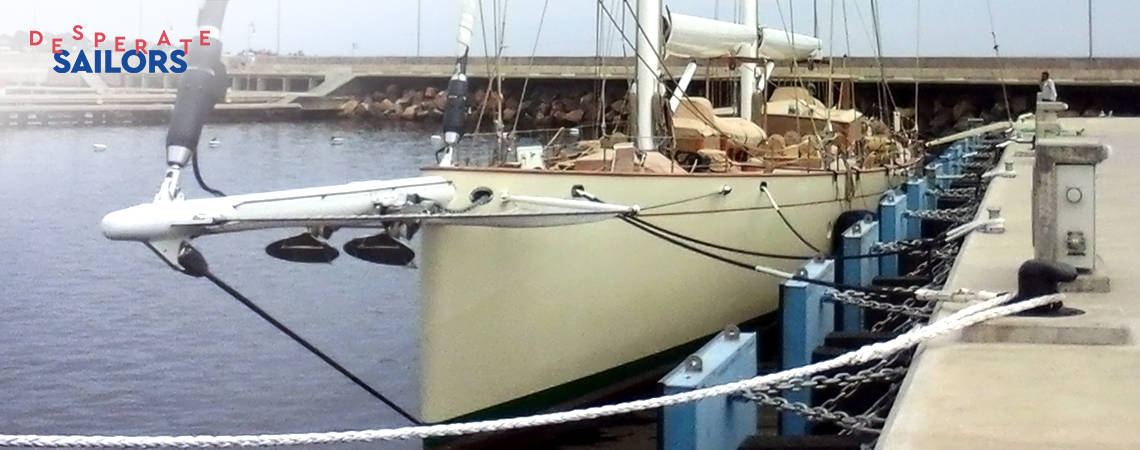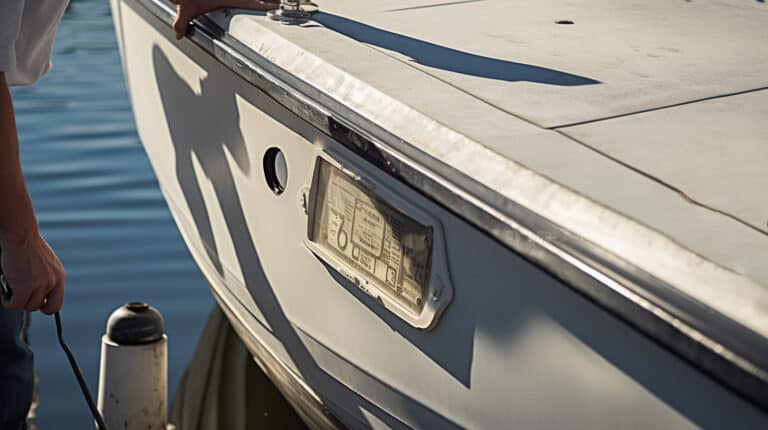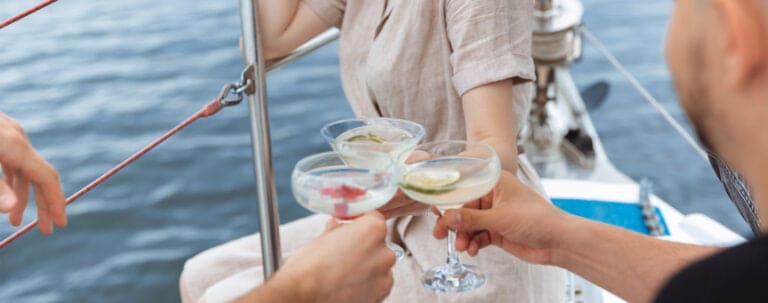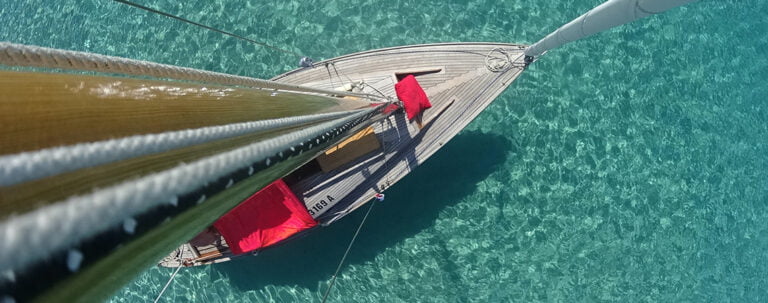You are probably wondering how to tie a boat to the dock correctly, without any stress or risking costly trouble or the laughter of others. Take it easy, I’ll help you with this.
Correctly tying a boat to a dock is stressful for any skipper, and it could be a novice skipper’s worst nightmare. It is somewhat scary to park a boat, which costs far beyond the average price of a regular car.
In addition to the one you are parking, you also must consider the value of the neighboring vessels that you could potentially touch in the process.
I once parked a car in Monte Carlo, and the feeling is the same, except that when you tap “stop” on the boat, she may not stop. She may even change direction, with unpredictable wind, currents, tides, and a panicking skipper on board.
Let’s find out how to tie a boat to the dock correctly and without stress…
- How To Tie A Boat To The Dock
- How To Tie Up a Boat To a Floating Dock
- How To Dock A Boat In a Tight Slip
- How To Tie a Boat To a Cleat
- How To Tie a Boat To a Dock With Tides
- How To Tie a Boat To a Dock Overnight
- What Speed To Choose When Entering And Maneuvering In The Port
- How To Tie Up A Boat – Bottom Line
How To Tie A Boat To The Dock
When mentioned in this post, a “regular dock” refers to a modern recreational marina where most skippers park stern-in, and the aisles and berths are relatively narrow.
TIP Later we’ll discuss old docks, ocean-side docks, and other docks where the sea is rough.
Step-By-Step Instruction of Parking And Tying a Boat to a Dock
The following are instructions for parking and tying a boat to a regular dock:
- Try your best to stay calm; she is not a spaceship, after all.
- Plan the whole operation, and think about what could go wrong. In a distressing situation, our brains may switch off some functionality, so planning ahead of time can help us to remain calm.
- Decide if you are going to park stern-in or bow-in. If you dock into the same marina you left from, you could have already decided about what direction to park in when you return. You can alter the decision later, but it is wise to have a solid plan – and maybe a spare plan as well – in mind.
- Ignore anyone watching and/or laughing as you park. You are the skipper, and you are always right as long as everyone and their property are safe.
- Check the chart to find out what is around the entrance in case you’ll need a maneuver. You may meet another boat leaving the marina (the boat going out has priority, logically), or perhaps there is a swimming area or shipwreck near the entrance. You may need to drop an anchor if you can’t get through.
SUPER HINT When approaching the dock, look at the masts in it – you can see them from a great distance – and if you see a mast moving, wait till she ends whatever she is doing. Safe and easy. - Throttle down. Choose the speed thoughtfully: the slowest speed is not a universal solution when you need to push harder than that to resist wind or a current.
- Get the ropes ready.
- If entering by sail, adjust the sail to ease the further operations. You will not have as much time as you have at sea. Close the jib, and be sure your main will fall down quickly and there are no issues with its mechanics. And yes, only the brave park with a sail!! 😉
- Have your anchors ready (including the stern anchor), because if you end up anchoring in the middle of the marina, you need to stop the movement in a limited space. So, be ready just in case. Hopefully you shall never need it.
- Rig the fenders, considering the wind direction, other boats’ location in the marina, how their mooring lines go into the water (if any do), and your slip location, keeping in mind which way you are approaching it. Put fenders on both sides! If one side needs better protection, do not ignore protecting the other side, just in case.
- Enter the marina reasonably slowly, also there is usually a legal speed limit. Remember the SOLAS rule about how to bypass another ship, because if you have another boat moving there, you do not have as much space as at sea. Some skippers (being newbies) really jump to the port side, and they can logically explain the motivation, but this is already too close to the end of the game.
TIP Communicating to another craft, be sure you are on the same page! If not sure, then follow the rules strictly, maybe except the displacement-based priority. If not sure, always give up priority, and in any case perform all maneuvers super-obviously for everybody, and mind the wind as usual
The speed you are going through a marina is the speed you wish to hit at.
- If you are a sailing boat, do not forget that in the dock you are a motorboat if maneuvering with sails down and motoring.
- To tie up the boat into a tight slip, consider using the prop-effect effectively (if you have one). Learn how to use it properly!
- You do not need to perform all operations superfast, but do them steadily and thoughtfully. Take seconds to think when possible. If all is planned well, you should have some time. Marinas are designed to decrease the wind and the waves and be safe places, but the marina designers are only human. I saw a marina in Uruguay which might have mooring buoys according to official documentation and the website, but there was not even space for mooring buoys!
- No showing off. Use bow-in entering if feeling uncertain. Don’t be shy about getting out of the marina (or back into an aisle) for a second try where applicable. Do not speed up. Get out of the berth and try again. You mustn’t worry about looking stupid, because that would be less of a “disaster” than what a show-off could cause.
To rephrase a famous quote, “Park like nobody is watching!”
- Shut off the engine as the last step. You keep it on till the end just in case you need it urgently. Use the reverse to stop the boat.
- Don’t be shy about “using” other boats, such as tying up to one temporarily or touching by the fenders if you are sure they are positioned well. Pushing other boats with a hook is better than hitting them, so don’t be shy. You can also step on them to push them away from your boat when fitting her into a tight slip; such is allowed if reasonable.
- If you or a crew member is pushing other boats with limbs, think of the limbs first. Boats are stronger than you think, and the limbs are weaker.
- Tie up the lines which will stop your boat first (those holding against the wind). Consider tying up to another boat as an intermediate step. Don’t forget to have an extra fender ready for an emergency. If you have a spare crew member, they should have the spare fender by the side where a possible hit could occur.
- Boats are much stronger than you think. A gentle touch is acceptable if reasonable. I didn’t tell you that – you are the captain; the decision is yours.
- Open your beer when it’s done.
There is no bulletproof algorithm to tie up a boat to any random dock. The recreational marinas have many similarities, but even those bear their unique features.
However, the general movement trajectory is pretty much like parking a car.
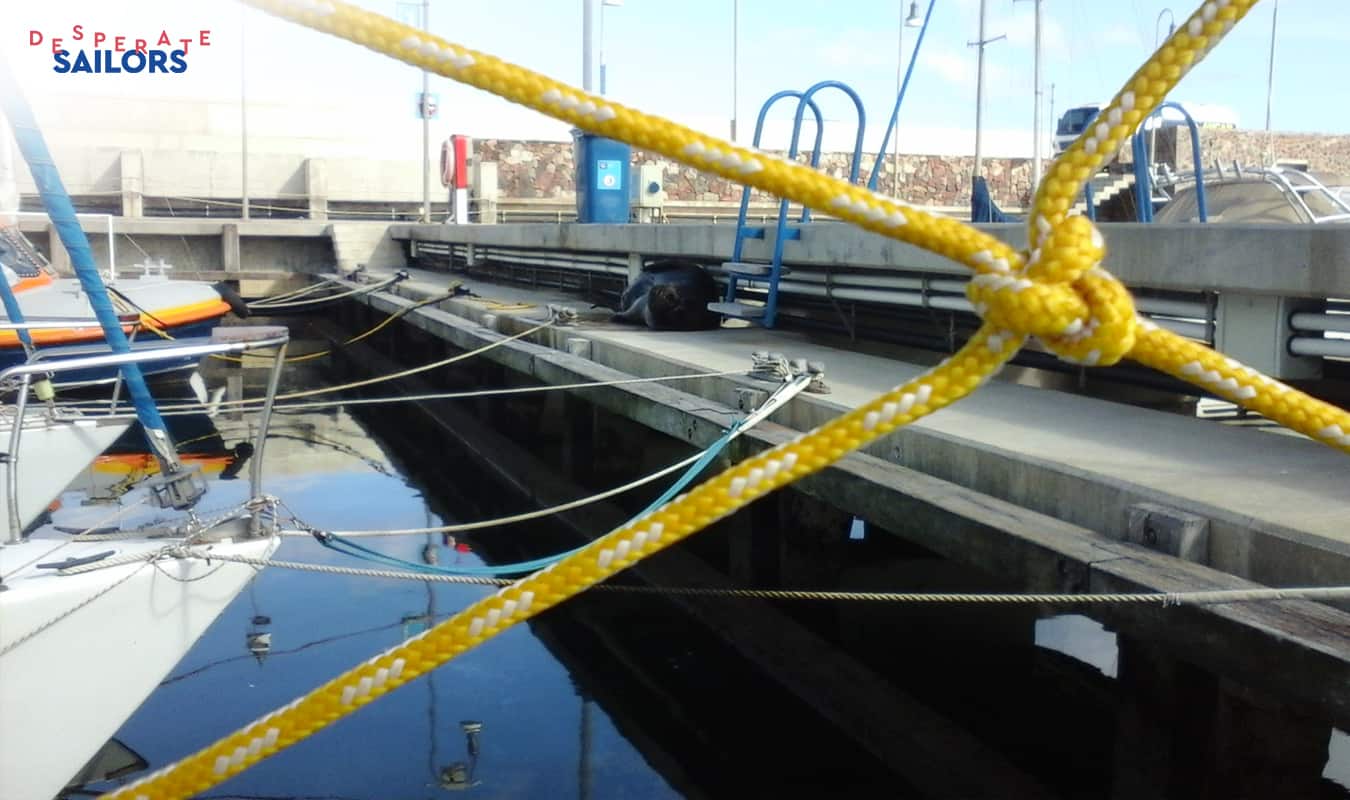
How To Tie Up a Boat To a Floating Dock
A floating dock is normally a private one, and there are no neighbors to hit, so you simply park alongside the dock. This is the easiest scenario of those mentioned in this article.
- If it is your dock, think about rigging fenders, rubber bumpers, or used tires upon it.
- Try to dock the way that the wind will push the boat to the dock. You may slow down a little bit before you approach the dock, and then the wind shall do the job gently.
- If you have no choice in which side of the floating dock you tie up, then tie up the first line in a way to stop the boat, and then tie all other ropes.
- Going against the wind is a good practice too, because in this case, the wind won’t allow you to “hit the wall.”
- Mind the spring lines. Those shall hold the boat, preventing its movement. So, you will need four ropes to tie.
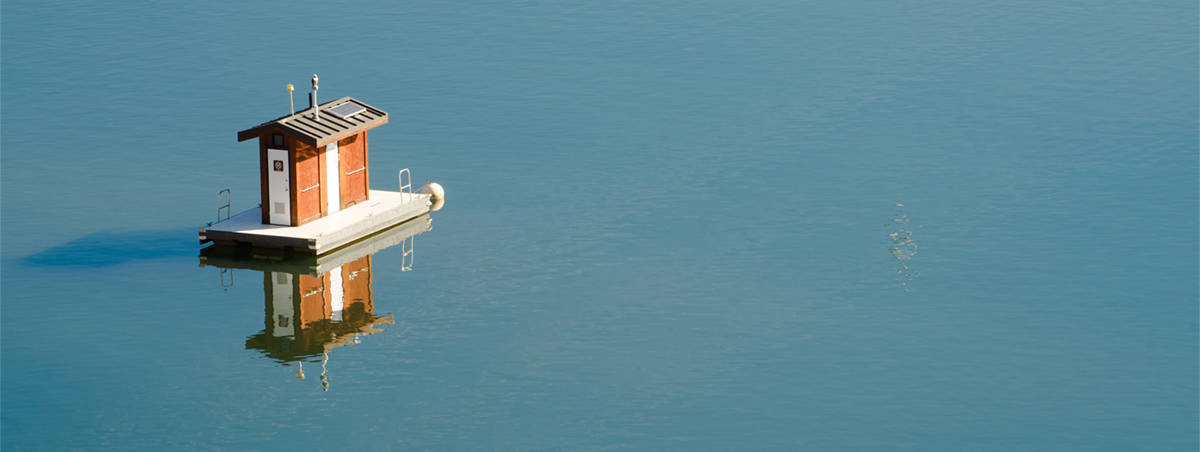
How To Dock A Boat In a Tight Slip
What Could Go Wrong?
The whole process is mentioned above, and we discuss now what else to expect if it is a tighter slip that you park into.
We list two possible bad scenarios below. Better to be prepared.
Thrusters
Don’t you forget that the bow/stern thrusters may decline on a stronger wind because they are positioned so, and they are designed to work in marinas in the flat water, which means no waves.
Thrusters may break from a long-term continuous use where the long-term is measured in seconds. Push the button repeatedly with the intervals to rest, but do not hold it for too long.
Thruster propellers can be easily blocked by seaweed, small sea animals, garbage from the marina, or any other matter, depending on the conditions of your voyage. Thrusters are fragile.
They are unreliable helpers, those boat thrusters. You should have a basic idea of what you are going to do once they are off or not performing well.
Underwater Ropes
Yeah, man, there are such: the line holding the side other than the one attached to a pier sometimes goes into the water. There can be a buoy for the purpose, but if not, there will be a line or chain going into the water, and you can take one upon your working propeller!
If you touch an underwater line with the hull, there should be no problem. It will likely only modify your trajectory, and you should just slide smoothly along.
However, the worst scenario is that you get that underwater line upon your propeller rolling. Such is close to gameover, Captain.
I think the best decision would be to stop the engine immediately to save the whole system and be sure your boat has fenders properly rigged for preventing even minimal damage:
- Adjust the fenders. Mind the wind as always.
- Consider tying up somewhere for the emergency, depending on where your boat follows once your propeller is blocked.
- Call for help from the harbormaster. Usually he is watching if you are the new boat entering the harbor. Do not expect that he will be a polite person if you take a rope upon your propeller, though.
The Prop Effect
Fenders are what you want. Yes, you need them anyway, but this time you want them more.
Mastering the prop effect is a nice idea. You can do it at sea, by the way, or in the marina before you leave it, so you know all the distances on your return.
You can touch other boats if you do it super gently. You certainly can touch other boats if you are sure you’ve placed your fenders well. Don’t be shy to retreat for a second try. No shame if you need ten retreats and ten re-tries; that is how mastery is gained.
The prop effect can ease your life, but it can cause problems too. You can use it for the maneuver, or not use it, but you’d better know which side the prop effect pushes your boat.
For the stern-in method, you can use the prop effect to insert the stern of your “spaceship” by a sharper angle, especially into the “narrow gates.” Such can be a much easier solution, and you can also use it for other maneuvers.
When you reverse your engine to stop the movement, the prop effect shall be there too.
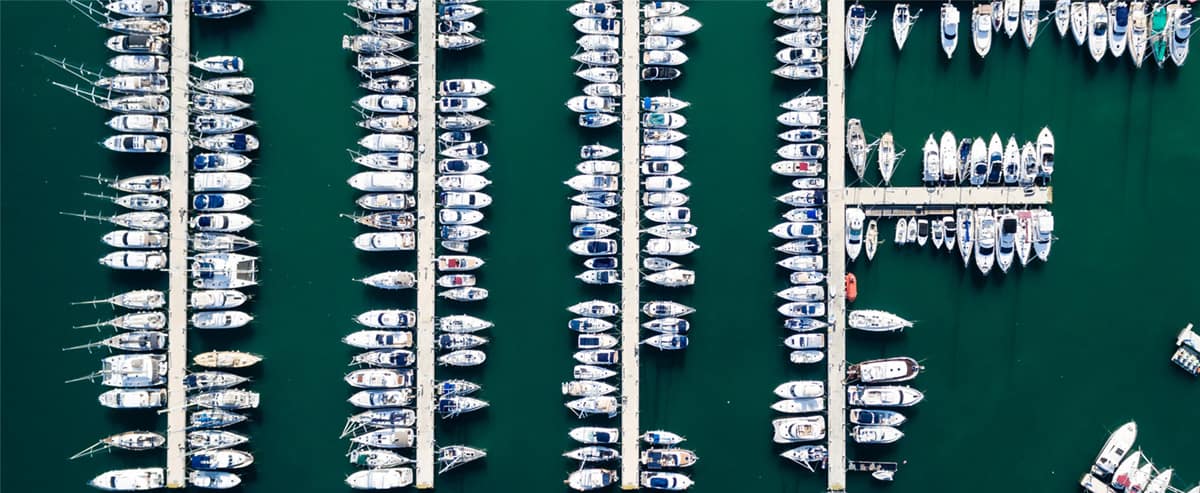
How To Tie a Boat To a Cleat
Now, the knot. A cleat is the metal t-shaped piece attached to the deck where you tie up the line end, whereas the other end is attached to the dock.
The knot is called the cleat hitch. It consists of one wrap around the base of a cleat, then several figure eights follow, and one-two half hitches in the end.
The easiest knot in sailing theory, I reckon.
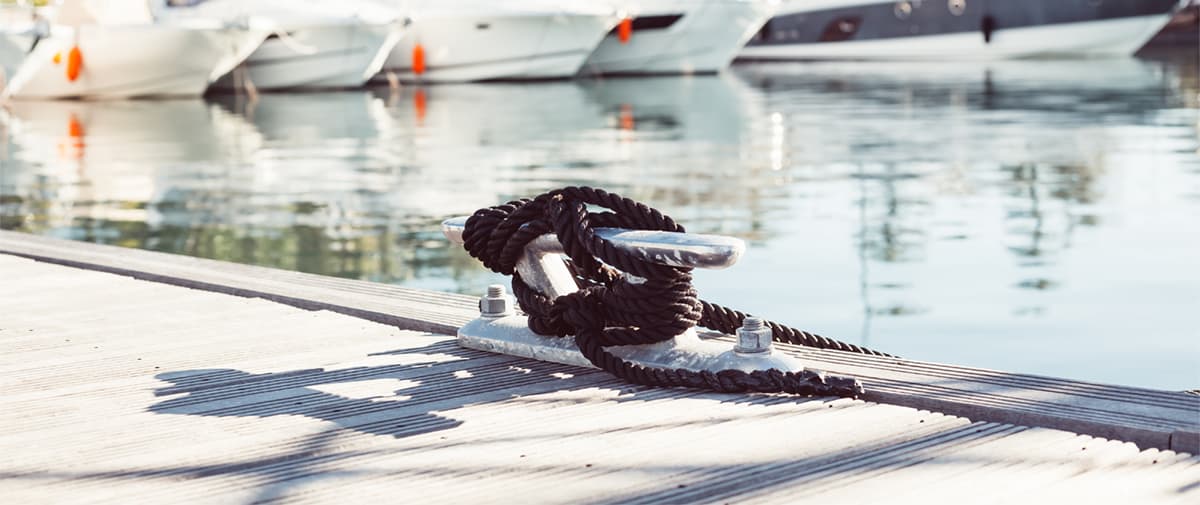
How To Tie a Boat To a Dock With Tides
This is the same as any other, except the sea level shall change, and that can push your boat closer to the pier or set it farther from the pier. In the former case, you can hit the pier. In the latter case, you can fail climbing upon her.
The experienced sailors suggest leaving as long a distance from the boat to the pier as possible. This also works when you tie a boat to a dock with the tides.
Use the slack water if you have an opportunity and a reason to use it. Tides suggest currents. Those can be stronger or weaker depending on the area, but keep slack water in mind.
How To Tie a Boat To a Dock Overnight
Do not forget to switch on the navigation lights. This may sound like obvious advice, but it’s an important reminder. Have you seen cars in the street at night with their headlights off? Now, who of us did not make this same mistake at one time or another?
In the night you see nothing except the lights. When approaching a dock overnight, you need the lights for everybody to see you clearly.
- Mind if it is Zone A or Zone B where you park the boat. Especially in the dark. The ignorance may crush your craft into the wall at full speed.
- Learn what is in the marina in the daytime, where possible, if you plan to be back at night. Study where the underwater lines and ropes you can touch (including with the propeller) are. Be aware of other obstacles in the water, the shallow parts of the marina where you do not go, and other environmental conditions.
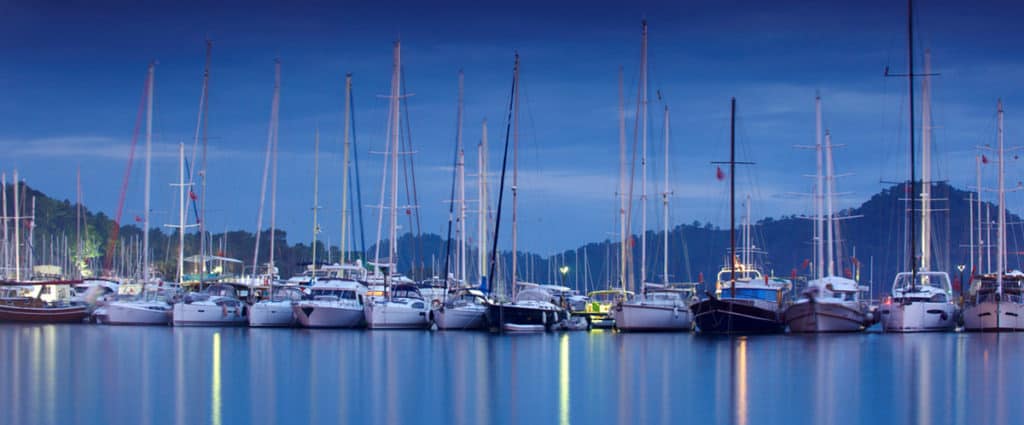
What Speed To Choose When Entering And Maneuvering In The Port
First of all, there is a legal speed limit in a dock’s jurisdiction. You must know it once you tie up your boat in that jurisdiction. There may also be a specific limit for a specific marina.
Ask the harbormaster if in doubt by VHF radio or by phone, in advance or not. A solution that works is the solution that fits.
Learn it as a mantra: your speed in the marina is the speed at which you are willing to hit a pier or another boat. A marina is not a racing track. You may race at sea, but in the marina, you park – no showing off.
You are the only captain of your boat. Legally and morally, you are always responsible for everything that is happening (or going to happen) to your ship or people aboard, without exception.
How To Tie Up A Boat – Bottom Line
Keep your eyes open, Capitan!
To wrap it up:
- Mind the entrance. There can be unusual waves, underwater lines, rocks positioned in a way you never saw before, a drunk fisherman sitting dangerously, a shipwreck… anything. I once met a canoe somewhere she should not have been at all! You might even come across a family of sea lions in a playful mood. Did you know those sea lions can jump on your deck for fun? But don’t throw your sailing license away yet! Keep going, Captain!
- Mind the wind at the dock! Pay attention to the wind and waves at the entrance. Docks usually have a wall protecting the space inside the dock against the wind and waves; therefore, a slightly different wind could be inside the dock. It could even push your mast stronger than the hull.
- Learn how to find your slip in the marina in advance. Check the chart, ask a harbormaster, check Google Maps or a navigational plotter, send a drone… whatever makes your life easier.
- Don’t be shy about the harbormaster. He is there to help you, and he is the last person who wants trouble in the marina. Not to mention, they are nice guys in general and usually very experienced. There is no shame in admitting you need help. There are no heroes at sea, remember?
- Practice makes perfect, but it’s not simple at all to arrange a “safe” practice with a boat! You go from studying knots in a classroom to tying up a $100k piece into a tight slip in the marina, surrounded by extremely expensive vessels.
Everything is moving, the wind is blowing, the harbormaster is watching… “nervous” is an understatement. Every dock tying experience will be a part of your education, errors and all.
Good luck, Captain!
